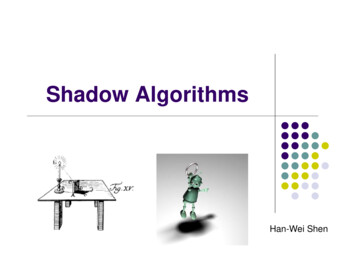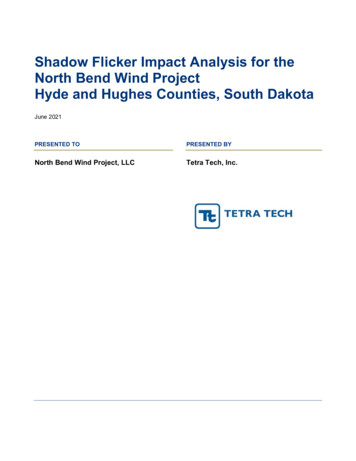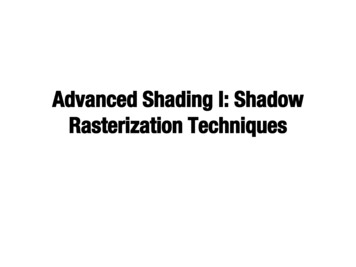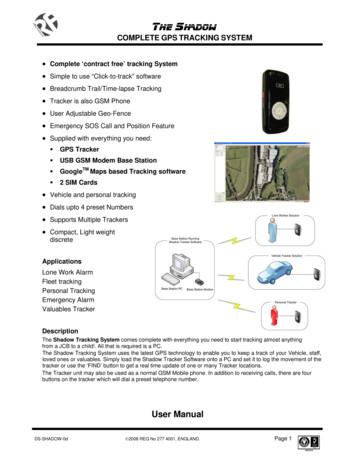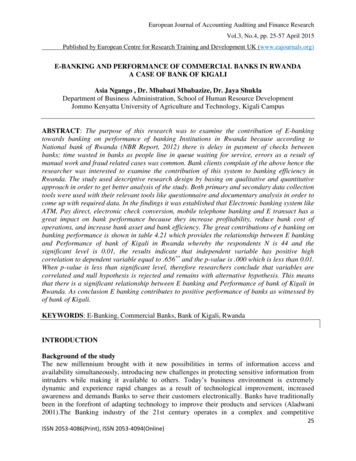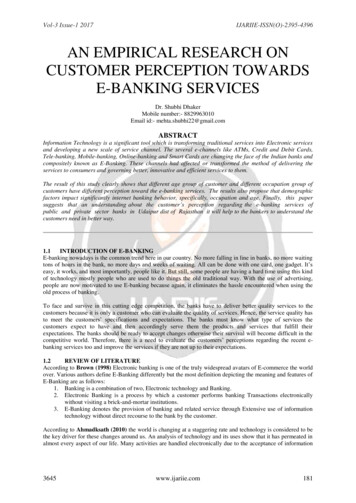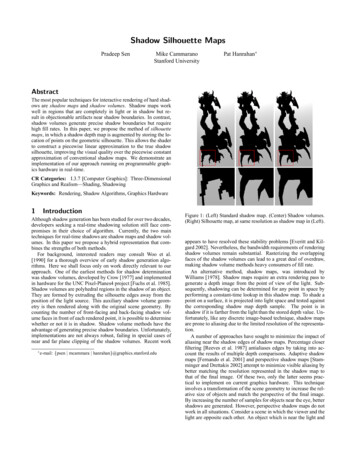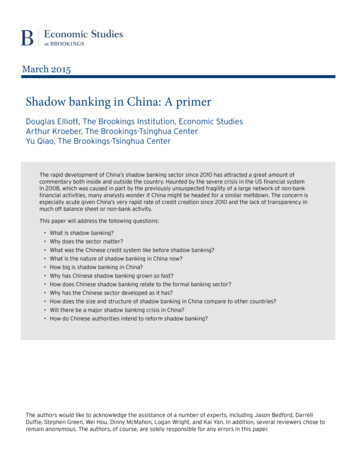
Transcription
March 2015Shadow banking in China: A primerDouglas Elliott, The Brookings Institution, Economic StudiesArthur Kroeber, The Brookings-Tsinghua CenterYu Qiao, The Brookings-Tsinghua CenterThe rapid development of China’s shadow banking sector since 2010 has attracted a great amount ofcommentary both inside and outside the country. Haunted by the severe crisis in the US financial systemin 2008, which was caused in part by the previously unsuspected fragility of a large network of non-bankfinancial activities, many analysts wonder if China might be headed for a similar meltdown. The concern isespecially acute given China’s very rapid rate of credit creation since 2010 and the lack of transparency inmuch off balance sheet or non-bank activity.This paper will address the following questions: What is shadow banking? Why does the sector matter? What was the Chinese credit system like before shadow banking? What is the nature of shadow banking in China now? How big is shadow banking in China? Why has Chinese shadow banking grown so fast? How does Chinese shadow banking relate to the formal banking sector? Why has the Chinese sector developed as it has? How does the size and structure of shadow banking in China compare to other countries? Will there be a major shadow banking crisis in China? How do Chinese authorities intend to reform shadow banking?The authors would like to acknowledge the assistance of a number of experts, including Jason Bedford, DarrellDuffie, Stephen Green, Wei Hou, Dinny McMahon, Logan Wright, and Kai Yan. In addition, several reviewers chose toremain anonymous. The authors, of course, are solely responsible for any errors in this paper.
Executive SummaryShadow banks are financial firms that perform similarfunctions and assume similar risks to banks. Beingoutside the formal banking sector generally means theylack a strong safety net, such as publicly guaranteeddeposit insurance or lender of last resort facilities fromcentral banks, and operate with a different, and usuallylesser, level of regulatory oversight. These characteristicsincrease the risks for financial stability, which is the mainreason there is a focus on shadow banks today.Shadow banks can help spur economic growth by makingfinancial services cheaper and more widely available, butthere is usually a trade-off in terms of reduced financialstability. One reason for the trade-off is that shadowbank’s flexibility and price competitiveness often comesat the expense of safety margins. Banks, for example,are generally required to have significantly more capitaland liquidity than shadow banks may choose to carry.Shadow banks are also less regulated. This combinationforces policymakers into difficult balancing acts to try tomaximize the benefits while minimizing the risks.Shadow banking in China must be viewed in the contextof a system which remains dominated by banks,especially large state-controlled banks, and in whichthe state provides a great deal of direction to banks,through a variety of regulations and formal and informalguidance. In the last few years, those constraints havebecome sufficiently binding that business has flowed toshadow banks.There are a number of pressures pushing business awayfrom banks towards shadow banks, including the factthat: There are caps on bank lending volumes imposed bythe People’s Bank of China (PBOC). The limit of bank loans to deposits of 75% isconstraining. Regulators discourage lending to certain industries. Most non-bank channels have lower capital andliquidity requirements. Shadow banks are not subject to bank limits on loanor deposit rates. Shadow banking avoids costly PBOC reserverequirements.Perhaps two-thirds of the flow of business into shadowbanking is effectively “bank loans in disguise,” wherea bank is at the core of the transaction and takes thegreat bulk of the risks and rewards, but pays non-banksThe Brookings Institutionto participate in order to avoid regulatory constraintsand costs. The other third or so of the business thathas moved results from a combination of competitiveadvantages for the non-banks, many due to looserregulation, and a willingness and ability to reach outto smaller, private sector businesses that are not wellserved by the banks.Shadow banking transactions generally make use of oneor more of the following techniques and instruments:Loans and leases by trust companies. Trust companiesare financial firms in China that have a quite flexiblecharter and combine elements of banks and assetmanagers.Entrusted loans. These are loans made on behalf oflarge corporations, using banks or finance companiesas intermediaries. They are most commonly to othercompanies in the same group or to suppliers orcustomers. There is also an interbank version, where onebank will act on behalf of another.Bankers’ Acceptances. These are notes issued by banksthat promise to pay a fixed amount a few months in thefuture. Generally these are supposed to be issued inconnection with a non-financial transaction, such as apurchase of goods, but reports suggest they are oftenused more loosely.Microfinance companies. These are separately regulatedfinancial firms that are licensed to lend in small amountsto help encourage credit access for small and ruralborrowers.Financial leasing. This represents leasing of all kinds thatis not already on a bank or trust company balance sheetand is not a short-term operating lease.Guarantees. Guarantee companies in China providefinancial guarantees, including to facilitate shadowbanking transactions. Many guarantee companies havebranched out to make direct loans, even though they donot have legal licenses to do so.Pawn shops and various unofficial lenders. Pawn shopsare important lenders to some households and smallbusinesses. In addition, there are other types of lendersthat operate informally or even clearly illegally.Trust Beneficiary Rights (TBRs). TBRs are effectivelya simple form of derivative transaction whereby thepurchaser of the TBR receives all or a stated proportionof the returns accruing to a trust. Banks sometimes useShadow banking in China1
TBRs as part of complex shadow banking transactions tokeep the economic benefits of a loan without showing itas a loan on their balance sheets, but moving it to a morefavorably treated investment category.Wealth management products. These are investmentproducts that provide a return based on the performanceof a pool of underlying assets. Typically the underlyinginvestment is a single large loan or a pool of loans.WMPs are generally offered by banks or trust companies,although securities firms offer similar products knownas Directional Asset Management Products. WMPs areincluded in discussions of shadow banking in large partbecause they are a close substitute for bank deposits.WMP investors generally assume that the target returnof these products is effectively guaranteed by any bankor trust associated with the product. WMPs are usuallypurchased by relatively wealthy investors as substitutesfor bank deposits, with the benefit of higher yields thanbanks are allowed to offer on formal deposits.Inter-bank market activities. Another substitute forformal deposits is created using the inter-bank market.Despite its name, many participants in this market arenot banks but are large corporations using financecompany subsidiaries to participate. They can lendmoney to banks in deposit-like arrangements withoutbeing subject to caps on deposit rates and withoutforcing banks to incur many of the regulatory costsof deposits, such as triggering the minimum reserverequirements.There is a range of estimates of the size of shadowbanking in China, depending on the definition of shadowbanking and estimates of some important statistics. Sixreasonable estimates in the recent past produced figuresranging from about RMB 5 trillion to RMB 46 trillion,or roughly 8 to 80 percent of the size of China’s GrossDomestic Product (GDP). Dr. Yu, one of our co-authors,estimated the size at RMB 25 trillion, or 43% of GDP, in2013. This compares to an estimate from the FinancialStability Board (FSB) that global shadow banking assetswere equivalent to 120% of GDP. On the same basis, theUS was at 150%. Thus, China’s shadow banking sectoris relatively small compared with advanced economies.Further, it is not especially large in comparison with otheremerging market countries as a percent of national GDP.Using figures from the PBOC’s measure of Total SocialFinance (TSF), shadow banking accounted for about 18%11. Calculated as the share of total net flows of TSF accounted for by trustloans, entrusted loans, and undiscounted bankers’ acceptances. People’s Bankof China, “All-system Financing Aggregate Statistics in 2014,” People’s Bank ofChina News, January, 29, 2015, available at 50129085803713420369/20150129085803713420369 .html.The Brookings Institutionof net flows of TSF in 2014. Despite the rapid growth ofshadow banking, it remains substantially less importantthan formal banking as a source of credit in China.One of the key questions is whether China could besubject to a severe crisis in shadow banking and howbad the damage might be in such an event. There iscertainly significant risk that a crisis could develop inshadow banking, for multiple reasons; among others:the business is inherently riskier than regular bankingand operates with smaller safety margins; China isgoing through some difficult adjustments economicallythat could trigger loan losses; and there is too littletransparency in shadow banking and too much relianceon implicit guarantees.However, the financial system and the centralgovernment appear to be well positioned to deal withsuch a crisis. First, shadow banking is small enoughcompared to the size of the total financial sector to behandled without disaster. Second, most of the shadowbanking is closely enough tied to banks that they arelikely to end up honoring their implicit guarantees anddealing with most of the mess on their own. Third, theauthorities have more than enough fiscal capacity todeal with even a large shadow banking crisis, given quitelow central government debt to GDP ratios, even whenadjusted for off-balance sheet obligations, such as theneed to rescue some local and regional governments.If this optimistic view is wrong, it is likely to be becausethe lack of clarity about shadow banking has hiddenlarger problems than appear to exist and also slowsdown and muddies a government response. A possiblecontributing factor would be if the anti-corruptioncampaign makes it too hard for authorities to make thenecessary decisions with the information available tothem. The financial system is much more complicatednow than the last time the government rescued it,when the major banks were completely owned by thegovernment and financial relationships were simpler allaround. Now there would be questions about how thegovernment chose to allocate costs and benefits across amuch wider range of players, many in the private sector.In sum, China’s shadow banking sector is not especiallylarge by international standards, is relatively simple (withlow levels of instruments such as securitized assets andderivatives), and is overseen by regulators who haveso far shown themselves alive to the most importantrisks (namely funding risk and lack of transparency) andhave taken prudent steps to minimize these risks. Theauthorities take seriously their mandate to maintainfinancial stability, and have acted pre-emptively (forinstance in the inter-bank squeeze of June 2013) to nip inthe bud practices that might threaten that stability.Shadow banking in China2
The problem for China’s financial authorities is that thevery large traditional banking sector is not fully servingthe increasingly complex financial needs of an economytransitioning from a focus on industry and infrastructureto one based mainly on consumer services and alsomoving from state ownership and control to a greaterlevel of private enterprise.The balancing act between encouraging shadow banks tosupply needed credit to sectors that are not well servedby traditional banks and at the same time protectingfinancial stability and investors is a very difficult one. Acompanion paper will present our recommendations forreforming shadow banking and implementing relatedchanges in the wider financial sector.The Brookings InstitutionShadow banking in China3
What is shadow banking?Shadow banking is not a new phenomenon, but the termonly recently came into widespread use,2 and there is nosingle agreed definition. The Financial Stability Board(FSB) broadly describes shadow banking as “creditintermediation involving entities and activities outsidethe regular banking system”3. The People’s Bank of China(PBOC) uses a definition of shadow banking that seeksto take the particulars of their own “national situationinto full account.” They define “China’s shadow banking[system] as credit intermediation involving entities andactivities outside the regular banking system” that servesto provide “liquidity and credit transformation” and“which could potentially” be a source of “systemic riskor regulatory arbitrage.”4 Some additional definitions ofshadow banking by various researchers are included inAppendix A.Whatever the precise definition, shadow banks performsimilar functions and assume similar risks to banks,namely those associated with maturity, credit, andliquidity transformation. Being outside the formalbanking sector generally means they lack a strong safetynet, such as publicly guaranteed deposit insurance orlender of last resort facilities from central banks. Theyalso operate with a different, and usually lesser, level ofregulatory oversight. All of these characteristics increasethe risks for financial stability, which is the main reasonthere is a focus on shadow banks today.We would like to acknowledge that “shadow banking”often has negative implications and sets banks as theappropriate comparison for institutions that sometimesshare only a few characteristics with banks (for instance,insurers or funds managers). We would prefer to usea more neutral term; however, the phrase has becomeso ingrained in public policy discussions that we feelcompelled to use it in this paper.All definitions of shadow banking pose practicaldifficulties, both in their precise definition and in theirusefulness for describing the real world. For example,it is difficult to draw the line between those institutionsand activities that are guaranteed by the governmentand those that are not. Formal definitions often provedeceptive when a financial crisis develops. For example,U.S. investment banks were suddenly swept into thesafety net previously available only to commercialbanks, once the Lehman insolvency occurred. In China,there is no guarantee system for bank deposits, but2. Paul McCulley, an economist and investment manager at PIMCO, is widelycredited with coining the term in 2007.3. Financial Stability Board (2013).4. People’s Bank of China (2013).The Brookings Institutionvirtually everyone assumed, we believe correctly, thatthe government would in practice protect bank deposits.(Thus, the promised creation of an explicit depositguarantee system may actually reduce the level of publicguarantees, since it will have coverage limits, similar tothose in most nations.)It is also harder than it may seem to determine if aninstitution is providing a banking-like service, such asmaturity transformation. Life insurers may issue longterm policies, but allow early withdrawal of funds undercertain conditions. Is this sufficient to view them asoffering maturity transformation in a significant way?For all of these reasons, varying definitions of shadowbanking can produce quite different estimates of the sizeof that system. Further, “shadow banking” is more of acatch-all than a category, encompassing a very broadrange of heterogeneous activities ranging from wellestablished, simple and normally low-risk practices (suchas money market mutual funds) to new, exotic and poorlyunderstood transactions involving one or more layers ofcomplex derivatives. This can make broad generalizationsabout shadow banks misleading.Why does the sector matter?Shadow banking has significant economic benefits andcosts. On the positive side, shadow banks can help fueleconomic growth by making financial services cheaperand more widely available. They can often operate morecheaply than formal banks and therefore provide lowercost loans and other financial services. They may alsobe able to offer services that banks cannot or cater tocustomers that banks cannot or will not serve.However, this flexibility and price competitiveness oftencomes at the expense of safety margins. Banks, forexample, are generally required to have significantlymore capital and liquidity than shadow banks maychoose to carry. This can be expensive5, but it makes thebanks safer. Further, shadow banks often lend to riskiercustomers or in riskier forms, such as by foregoingcollateral protection that a bank would require. They alsogenerally operate with much less regulatory supervision,which is designed to curb excessively risky behavior. Asa result of all this, shadow banks tend to be substantiallyless stable than banks. Further, they fall outside thepublic safety nets of deposit guarantees and lender of5. In the first instance, capital is more expensive than debt and depositsbecause funders demand higher returns to compensate for their greaterrisk from investing in equity and other capital instruments. As described byModigliani and Miller in their classic work, this can be offset by the increasedsafety of a firm that holds more equity. In practice, this is only a partial offset,as described further in Elliott (2013). There is a similar logic with liquidityrequirements.Shadow banking in China4
last resort facilities that protect banks, so instability atthese institutions can spread and accelerate faster thanwith banks. Panic is more likely to occur in relation toshadow banks and the public mechanisms to halt suchpanics are ad hoc in nature and therefore have lessercredibility and more risk of failure.In sum, shadow banks can help spur economic growth,but usually do so at the expense of financial stability. Thisforces policymakers into difficult balancing acts to try tomaximize the benefits while minimizing the risks.In China’s case there is an added factor to the balancingact. The authorities recognize that the financial sectorneeds to be liberalized with a range of important reformsthat will reduce State control of banking decisions. Theincomplete nature of current reforms leaves banksmuch more constrained than in advanced economies,as described below. This creates many favorableopportunities for non-bank channels to compete withbanks through “regulatory arbitrage.” In policy circles,this term is virtually always meant as a strong negative.However, in an over-regulated economy with too largea State role, there can be societal benefits from suchregulatory arbitrage. It can diminish the deadweightcosts of inappropriate or excessive regulation and it canhelp force the pace of more comprehensive reforms.What was the Chinese credit systemlike before shadow banking?Banks completely dominated China’s credit systemfrom the start of the era of “reform and opening up”in 1978 until shadow banking began to take off in the2000’s. Even as recently as the end of 2008, banks loansrepresented almost 7/8th of outstanding credit in China.(Those readers interested in a broader overview of theChinese Financial System can see Elliott and Yan (2013)).Banks inherited a privileged position as reform began inChina, including:Customer base. Almost all lending under the statecontrolled system was done through banks, giving them ahuge existing customer base, especially with the StateOwned Enterprises (SOEs) that dominated the economy.Legal protections against competition. There were fewlegal alternatives to bank deposits or bank loans inChina’s highly controlled economy.Implicit guarantees. Banks benefitted from a free implicitguarantee on their deposits, since it was inconceivablethat the State would allow any significant loss fordepositors, despite the lack of formal guarantees. ThisThe Brookings Institutionsafety allowed banks to gather large deposit volumesdespite paying low rates.Regulatory controls on deposit and loan rates. Banks hadthe advantage of a system of regulatory limits on themaximum deposit rate they could pay and the minimumloan rate they could charge. These were intended in largepart to ensure that they had healthy profit margins.These major advantages were partially offset by anumber of significant burdens imposed by the State:Controls on loan volumes. Chinese monetary policy waslargely run by controlling the volume of bank loans, whichproduced a similar effect to controlling overall moneysupply, given the dominance of the banks. The PBOCset limits for total loan volume by banks in aggregateand these limits were then apportioned out to individualbanks. In recent years this has left banks unable to makethe full volume of loans they would have liked.Micromanagement of lending. In the initial period ofreform, many bank loans were still made on the basis ofdirection from important government or party officials.This type of direction is much rarer now, although it stillappears to happen at smaller banks that are closely tiedto government entities at the regional or local level.However, even the largest banks receive broader-basedinstructions to avoid or limit lending to certain industriesthat the government feels need to shrink, such as coalmining. This may conflict with the banks’ preferredstrategies and may even make it difficult for them tocontinue supporting firms to whom they have existingloans that could be endangered by a sudden pullback ofcredit.Strict loan to deposit ratios. Banks are not allowed to lendfunds equal to more than 75% of their deposit volumes.Recently, this has been a serious constraint on loangrowth, especially as conventional deposit growth hasslowed sharply in the face of competing products, usuallyfrom the shadow banking realm. Regulators recentlybegan allowing some non-traditional deposits, such asfrom the inter-bank market, to be counted in this figurein order to provide more leeway.High reserve requirements. Banks are required to holdsubstantial reserves as deposits at the PBOC, earningrates far below what banks could earn on their normalbusiness and even below their own cost of funds. Thislevel varies, but currently about 19.5%6 of deposits must6. The PBOC cut the required reserve ratio by 50 basis points for most smalland medium sized and rural banks in June 2014. It followed up this looseningin February 2015 by cutting the ratio by 50 basis points for the larger banks aswell. As of February 6, 2015, rural credit cooperatives and small financial institutions face a required reserve ratio of 16.0%, small and medium sized banks17.5%, and large depository institutions 19.5%.Shadow banking in China5
be placed with the PBOC. This is a considerable economicburden. For instance, an opportunity cost of 3 percentagepoints a year on 20% of deposits would be 0.60% ontotal deposits. Deposits remain the major source ofbank funding, so the reserve requirements represent asubstantial cost in aggregate.Until recent years, the positives of being a bankoverwhelmed the negatives and helped account for thedominance of banks as credit providers. However, asdescribed in the next section, this balance has swungconsiderably and created large opportunities for shadowbanking.There were other important features of the credit systemat the beginning of the 2000’s and prior:Bond markets were tiny. Financial markets tend to beimportant providers of funds to large corporations inadvanced economies and China is slowly moving in thisdirection. However, it is only recently that this becamea significant source of funds for businesses. Even now,much of the bond purchases are made by banks for theirown accounts, overstating the importance of the bondmarkets’ 15%7 share of total credit provision.Banks were state-owned. Until 20048 all of the majorbanks in China were 100% owned by the State. Even now,majority shareholdings give the government effectivecontrol of all major banks. Along with State ownershiphas come a strong role for the Communist Party of China(“CPC” or “Party”), particularly in personnel decisions.The top positions at the biggest banks are filled by theOrganization Department of the CPC and those chosenexecutives often move to senior State positions overthe course of their career. This presumably producesa different outlook and set of choices by senior bankexecutives than if they were competing in a free labormarket and focused on private sector careers.Banks favored SOEs in their lending policies. Banks inChina have a strong tendency to lend to SOEs and thisbias was even greater in the past. SOEs are favored for avariety of reasons, including: implicit State guarantees;favored market positions for some SOEs that makethem better credit risks; internal reward and punishmentsystems that mean a failed loan to an SOE is unlikelyto be punished severely while bad loans to the privatesector can lead to job loss; social/career considerationsthat make lending to entities run by powerful Partymembers attractive; and even direct pressure from7. Calculated as the proportion of total social financing accounted for by netfinancing of corporate bonds.8. Starting in 2004, China began transforming the wholly state-owned banksinto joint-stock corporations in a process called “equitization.” See Martin(2012).The Brookings InstitutionParty or State officials. The last factor is of decreasingimportance, but has not vanished.Conversely, banks failed to fully serve small andmedium-sized enterprises (SMEs) in the private sector.The bias towards SOEs is exacerbated by a clear biasagainst private sector entities, especially SMEs. This isunfortunate, since much of China’s economic growthhas come from these firms, which are reported to haveprovided 70% of employment and 60% of China’s GDPin 2012, while receiving only 20% of bank loans9. (Thedisparity may be less than this, although still large.Different sources provide varying figures, partly becausethere is no authoritative definition of SME in China andthe numbers can be quite different depending on whichfirms are included, which makes is particularly hard tocompare shares of bank loans with shares of employmentor GDP, for example. Lardy (2014) does a particularlythorough job of trying to capture all SMEs and estimatesthat 36% of total business loans in 2012 went to SMEs10.)It must be noted that most nations find it difficult tochannel sufficient credit to SMEs, but this problemis substantially more severe in China because of thestructure of the banking sector and the many incentivesand constraints they face that over-ride pure profitconsiderations.In addition to a specific bias towards SOEs, and thereforeaway from everyone else, there are further reasonsthat banks neglect SMEs. First, SMEs lack high-qualitycollateral and long credit histories and are associatedwith higher risk. This is particularly problematic in abanking system that relies heavily on collateral, asChina’s does. Second, under the current commercial bankcredit manager responsibility system, the punishment forprivate enterprise loan default is much higher than is thepunishment for SOE loan default11.There has been some improvement in the abilityand willingness of banks to lend to SMEs, due to acombination of government and market pressures.One analyst argues that this is happening faster thangenerally appreciated, writing in a private communicationthat “joint stock banks in particular operate in a semiliberalized environment by virtue of the fact that theyhistorically played the role of corporate banker – andmore and more corporate deposits are appearingas inter-bank deposits where rates are not capped.9. Sheng (2015). Please note that it is unclear from the report in what year the20% of bank loans figure is for. Some other sources suggest figures closer to30% for SME loans in 2012.10. See Lardy (2014), Appendix A, particularly Table A.2.11. For example, in a private communication, Elliott was told that the headof SME lending at one provincial bank has a firm cap of 3% for the level ofnon-performing loans, above which he has been told he would lose his job.Shadow banking in China6
Consequently, these banks need to achieve riskefficient returns thereby forcing them to lend to theprivate sector. Similarly, for city and rural commerciallenders they often are locked out of most SOE lendingopportunities and must lend to the private sector.” Thesame analyst argues that more and more banks aresetting up specialized risk assessment processes andprocedures for SMEs.Nonetheless, despite progress that has undoubtedly beenmade, even optimistic analysts generally agree that SMEsremain at a considerable disadvantage with banks, overand above those confronted in other countries.What is the nature of shadowbanking in China now?As noted at the beginning, there are multiple definitionsof shadow banking, and therefore no consensus on whichactivities are included and how large the aggregatevolume is. Typically, the following types of lending orother financial activities would be included:Trust loans and leases. Financial transactions undertakenby trust companies, a separately regulated type of firmthat combines elements of banks and fund managers inWestern financial systems. Trust companies have widelatitude to operate across the financial sector, althoughregulations are increasingly tightening constraints ontheir activities.Entrusted loans. These are loans made by firms in thenon-financial economy that are run through banks forlegal reasons, but with the banks indemn
The Brookings Institution Shadow banking in China 2 TBRs as part of complex shadow banking transactions to keep the economic benefits of a loan without showing it
